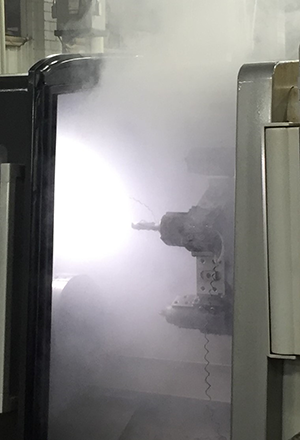Mist Mitigation: Protecting Your Employees’ Health, Protecting The Air We All Breathe
This blog post was written by our friend Rosemary Panici of 3nineUSA, Inc.
Why 3nine?
When choosing an oil mist collector, it is important to consider several key features to ensure that it is effective and sustainable. CNC operators are exposed to oil mist with contaminants generated by metalworking fluids and oils, which can cause serious health issues such as eye, nose, and throat irritation, as well as respiratory problems like chronic bronchitis or COPD. Long-term exposure can also lead to heart attacks and arrhythmias in people with heart disease. Therefore, removing oil mist is not just important but a critical step for workplace safety, cleanliness, and environmental protection.
3nine was founded in Sweden to address the oil mist problems of the metalworking industry. When it comes to achieving pristine industrial air quality, there are two options: separation technology and traditional filter-based collection methods. 3nine has been a pioneer in this field for over two decades, and we firmly believe that the superiority of our groundbreaking approach to separating particles instead of merely collecting them in filters is transforming industries worldwide.
The 3nine US office has been offering reliable solutions to the North American Metal metalworking industry since 2009, effectively addressing their oil mist problems. Our innovative technology, based on disc stack separation, delivers unparalleled purification with minimal maintenance. Our technology guarantees clean air at the lowest total cost of ownership. For over a decade, 3nine has been making significant strides in disc stack separation, acquiring over 100 global patents.

Separation Technology’s Precision
In an era where precision and efficiency reign supreme, separation technology is a testament to innovation. Unlike conventional filter-based methods that simply collect particles in a filter media, our approach directly separates oil mist, dust, and particles from the airflow. The advantages are undeniable:
- Elevated Efficiency: Our separation technology does not just clean the air; it does so with unparalleled efficiency. Preventing particles from infiltrating vital machinery not only ensures cleaner air but also extends the lifespan of equipment, minimizing costly downtime.
- Sustainability at Its Core: Beyond cleaner air, the separated particles can be recycled, aligning with sustainability goals, and minimizing waste.
- Cost-Effective Longevity: While the initial investment may be marginally higher, the long-term savings are substantial. Reduced filter replacements, less downtime, and lower maintenance requirements translate to improved cost efficiency.
Filter-Based Collection Challenges
Filter-based collection methods have long been the bedrock of air purification, offering reliability and familiarity. Yet, as industries evolve, this method faces challenges:
- Maintenance Demands: Filters require regular maintenance and replacements, increasing operational costs over time.
- Diminished Efficiency: As filters accumulate particles, their efficiency diminishes, potentially affecting air quality and equipment performance.
3nine’s Permanent Media
Many competing filtered technologies suggest a higher flow rate (CFM/m3/h) than 3nine, simply because they need to do so. Mechanical solutions, for instance, require 3-4 times more CFM/m3/h due to their filters and longer pipe runs, which ultimately lead to pressure drops. Four main factors, namely filters, contaminants, airflow, and viscosity, contribute to pressure drop. Technologies that rely on filters require multiple filter changes, as filters get saturated, leading to pressure drops that necessitate more CFM when using other technologies compared to 3nine.
3nine’s permanent media eliminates pressure drop, resulting in high efficiency, as none of the processed air is pulled through a filter. It’s easy to determine the CFM/m3/h you need for your machine tool with 3nine. Simply measure the cubic footage/cubic meters (WxDxH) of the cabin, and then refer to the unit specifications to determine the maximum cabin size that each oil mist collector can handle.
Oil mist can cause damage to your electrical equipment, circuit boards, and machine tools. It can also contaminate the components of your CNC machines, reducing efficiency and creating a potential fire risk. To prevent these issues, 3nine offers a unique solution. Our permanent media cleans to 1 micron before passing through a final stage HEPA filter, delivering consistently clean air that is 99.9% free from mist and smoke fumes. In contrast, typical mist collection systems only clean to 3-micron. Our H13 HEPA filter ensures that our cleaning process goes down to .03 microns, which is much more effective.
It’s important to note that not all HEPA filters are created equal. That’s why 3nine uses only Freudenberg grade H13 HEPA filters, which are designed specifically for mist applications. These filters can last up to 18,000 hours, much longer than other filters. Moreover, all Freudenberg HEPA filters are certified and undergo integrity tests, ensuring high quality and reliability.
HEPA filters are classified from H10 to H12, but those considered medical grade fall under the H13 category. They are often used in hospitals and are known to be the most effective method of air filtration. One satisfied customer claimed that their filter lasted for 3.5 years, running 24/7. With 3nine, replacing the HEPA filter is quick and easy. All it takes is four quick-release latches, and no tools are required.
3nine has developed and patented an automated cleaning system known as CIP, or Clean In Place. This system uses a pump and a timer that utilizes oil or coolant from the clean side of your machine tool’s sump. The CIP sprays a 4-second blast of fluid on the disk stack and rotor approximately every 10 minutes to clean it, maintaining separation efficiency without any human intervention. This results in minimal maintenance requirements and consistently high efficiency in purifying the air.
If you want to maintain the efficiency of your machinery, it is important to perform maintenance according to the manufacturer’s recommendations. These recommendations may differ depending on the technology used, but in all cases, maintenance is usually required several times a year.
Our mission is to revolutionize the CNC Machining, Grinding, Swiss-type machining, and metalworking industry while providing 99.9% clean air, keeping sustainability, cost-effectiveness, and efficiency in mind. Our vision is Clean Air for everyone! Our innovative technology provides the lowest total cost of ownership.
